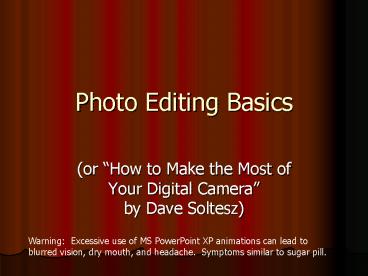Photo Editing Basics - PowerPoint PPT Presentation
1 / 17
Title:
Photo Editing Basics
Description:
Airbrush: Works like an artist's airbrush or can of spray paint. Pencil: Gives ... Pick one of the pictures of a faculty member (or any other picture) from the ... – PowerPoint PPT presentation
Number of Views:112
Avg rating:3.0/5.0
Title: Photo Editing Basics
1
Photo Editing Basics
- (or How to Make the Most of Your Digital
Cameraby Dave Soltesz)
Warning Excessive use of MS PowerPoint XP
animations can lead to blurred vision, dry mouth,
and headache. Symptoms similar to sugar pill.
2
Common Tools
- Regardless of whichever photo editing software
you use, there are file basics and common tools
that operate similarly. - We will focus on the basic tasks that apply when
working with digital images acquiring, editing,
and saving the image.
3
Step 1 Acquiring Images
- Images can be acquired from many different
sources (Mavica, Internet, Paint, email, scanner,
etc.) - The important thing is to get the correct file
format that you need to work with (jpeg, gif,
bmp, tiff, targ, pcx, et. al.) - Keep it simple. For web and email, stick to
jpeg.
4
Mavica Images
- Your Mavica images will likely be called
MVC-001.JPG or MVC-003F.JPG with the number or
letter changing. The other files called
MVC-001.411 are for info only and not needed by
other programs. - Those are saved to floppy disk and can be copied
over to your hard drive like any file.
5
Internet Images
- Right click on the image and chooseSave Picture
As - Choose a folder on your hard drive (C) or
wherever you want to store itnot floppy. - If the image is a background image, youll have
to choose Save Background As
6
Scanning Images
- PREVIEW the area before you scan.
- After the preview, CROP the area that you want to
scan to save file size and time editing. - Select a normal quality. You do NOT need super
high quality when scanning photos. If for email
or web use, 200-300 dpi is more than enough. - Never select 1200 or 2400 DPI!
7
Step 2 Editing Images
8
Step 2 Editing Images
9
Common Menu Choices
File Open, Open Recent, Save, Save As, Export,
Print, Exit Edit Cut, Copy, Paste, Undo Image
Rotate, Resize View Zoom In, Zoom Out Window
Cascade, Tile
10
Common Tools
Text Select Tool Rectangular Marquis Tool
This is used to select an area that you want to
do something to afterwards. Move Tool Moves the
area that is selected Lasso Tool Free Form
Select Used like the select tool but requires
steady hands and a clean mouse ball as you have
to do it free hand. Airbrush Works like an
artists airbrush or can of spray paint. Pencil
Gives a solid line. Holding SHIFT key changes
how this tool operates. Eraser Difficult to
master. Erases everything or just part of what
you have added.
11
Common Tools Continued
Smudge Used to blend one area into another
area. Imagine you have a gob of paint on the
canvas and use your thumb to smudge it into
another area. Pick Color Eyedropper Tool Used
to match the color in one pixel and copy that
color to the palette. Fill With Color Paint
Bucket Tool Used to fill objects with the color
of paint selected on the palette. Crop Tool
Used to select only a certain region and delete
anything outside that region. Can be duplicated
by SELECTING a region and then using COPY,
opening a new document, then PASTING. This tool
saves time! Text Horizontal Type Tool Used to
add text to your image.
12
Step 3 Saving Images
- Different file formats have advantages over
others. - In general, photographs should be saved as JPEG
(JPG) files and illustrations with flat color,
sharp edges, or type should be saved as GIF.
Image courtesy of Adobe Photoshop Elements Help
file.
13
JPEG vs. GIF
- GIFs usually result in a smaller file size.
- JPEGs usually result in a better quality picture.
- GIFs must be used if you want to animate the GIF
(advanced.) - GIFs must be used if you need transparency for
fancy web buttons (advanced.) - JPEG can support 16,777,216 colors while GIF
supports 256 colors (normal screen can show
512,000.) - However, to keep things easy, I suggest saving
everything as a JPEG and reduce file size by
cropping and adjusting resolution (quality.)
14
Can you tell the difference?
15
Photo for Email or Web?
- Be considerate to your recipients and ISP. They
cant delete the file without downloading it
first. - When saving, either choose JPEG with a low to
medium quality or choose GIF to reduce file size. - 450kb 163 seconds over 28.8
- 51.5kb 19 seconds over 28.8
16
In Conclusion
- Keep it simple. Less is more.
- Always work with a copy, not the original.
- Have fun!
17
Activities
- Pick one of the pictures of a faculty member (or
any other picture) from the John Marshall Webpage
http//jmhs.mars.k12.wv.us. Save it to a folder
on your computer and then improve it by using the
crop tool. Save it as a new file with version2
included in the file name. - Give the head of someone in this room a new body.
What is the best way to do this?

